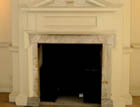Choosing Georgian fireplace surrounds
William Palin braves the fury of a Rottweiler to find marble for fireplaces


When I bought my decrepit early Georgian London townhouse it was suffering from a serious identity crisis. It had a shopfront from about 1800, Edwardian doors and several late Victorian cast iron fireplaces. These fireplaces, not the prettiest of their kind, and allegedly fished out of a skip by the previous owner, were a particular source of irritation to the Georgian buffs who visited in the early days so much so that I became quite fond of them. However, as I began work on restoring the panelling in the principal rooms, the Victorian interlopers were necessarily moved upstairs. In Georgian townhouses of the Spitalfields type, the treatment of fireplaces tends to be fairly simple the designs, usually integrated into the panelling, were adopted from builders' pattern books. Stone surrounds are rare, but can be found in a clutch of houses built by a paviour in Elder Street. Most of the other Spitalfields builders were carpenters, so the original surrounds tend to be made of wood, with each builder adopting a favourite design. At the smart end of the scale is the wonderful Rococo carved fireplace with inset Delft tiles in a 1750s house in Fournier Street. The house is one of two built by a third-generation Huguenot silk weaver, one for himself, the other for the French minister. One of these houses is currently under repair, and the architect, Chris Dyson, has recently replaced a missing chimneypiece with a copy of a delightful wooden survival from next door pictured above in its unpainted state. For my replacement fire surrounds, I opted for a design featuring marble slips set inside a wooden moulding with 'ears' or square projections, a common type in the area. For the marble slips, I was sent by a neighbour 'in the know' to a monument mason in Limehouse. This trip was an experience I will never forget. I arrived to find the yard completely deserted strewn with blocks of marble like a classical ruin. I was about to give up when I heard loud barking, and moments later a Rottweiler came dashing towards me, slavering. I was back inside the car in a flash, and for several minutes, I watched in terror as the fanged head bounced up and down outside my window. Eventually, a man emerged from a cabin, the dog was summoned and I was freed. There then followed a peculiar exchange, during which I pointed to the nearest block of marble, mumbled some dimensions, agreed a price and left. Days later, my marble was ready for collection: six beautiful slabs, all for the price of a low-grade reproduction fireplace. I could not bring myself to throw away my Victorian fireplaces, however. I put one out in the garden, where it is now a curious, overgrown 'feature', and another in the bathroom, where, I am pleased to say, it still draws sighs from the Georgian purists. The best guide to Georgian fireplace design is Georgian Chimneypieces, published by The Georgian Group; telephone 020?7529 8920 or visit www.georgiangroup.org.uk. For Chris Dyson Architects, telephone 020?7247 1816 or visit www.chrisdyson.co.uk
Sign up for the Country Life Newsletter
Exquisite houses, the beauty of Nature, and how to get the most from your life, straight to your inbox.
Country Life is unlike any other magazine: the only glossy weekly on the newsstand and the only magazine that has been guest-edited by HRH The King not once, but twice. It is a celebration of modern rural life and all its diverse joys and pleasures — that was first published in Queen Victoria's Diamond Jubilee year. Our eclectic mixture of witty and informative content — from the most up-to-date property news and commentary and a coveted glimpse inside some of the UK's best houses and gardens, to gardening, the arts and interior design, written by experts in their field — still cannot be found in print or online, anywhere else.
-
 Some of the finest landscapes in the North of England with a 12-bedroom home attached
Some of the finest landscapes in the North of England with a 12-bedroom home attachedUpper House in Derbyshire shows why the Kinder landscape was worth fighting for.
By James Fisher
-
 The Great Gatsby, pugs and the Mitford sisters: Country Life Quiz of the Day, April 16, 2025
The Great Gatsby, pugs and the Mitford sisters: Country Life Quiz of the Day, April 16, 2025Wednesday's quiz tests your knowledge on literature, National Parks and weird body parts.
By Rosie Paterson